 |
|
 |
Kyobashi, known for being one of the 8 best scenic spots in Edo (modern day Tokyo), in Ukiyo-e woodblock prints, is a historic and traditional city. An accessible market using the water system for transportation was founded in 1664 in Kyobashi. The city was named after the first bridge on the old Tokaido road that connected Nihonbashi to Kyoto, located in the south of the city. The name means “a bridge to Kyoto.” Kyobashi has been an active business district with various companies, traditional stores, and so on to the present day. We interviewed Maestro Satoru Nakamura, the 8th owner of “Shirokiya Denbe”, and received a warm tast
of an Edo style broom store this month. |
 |
 |
| Brooms originated in Shinto Rituals |
 |
Brooms were first used for sweeping purposes in Heian period. Bamboo, straw, or hemp were used to make brooms at the time. It was after the Edo era began when broom cypress began to be used for making brooms. Brooms in Japan were essentially used as a magical tool - for example, to stroke down a pregnant woman’s stomach with a broom today is still customary, after 400 years. Perhaps an aristocrat’s profound desire for peace was the beginning for this quiet and gentle tool.
|
|
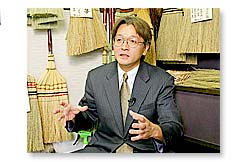 |
 |
| A Reevaluation of Traditional Techniques |
 |
“Shirokiya Denbe” was founded in 1830 in Ginza, first as a tatami-mat maker. Later on,
after specializing in making brooms, the techniques have been handed down from generation to generation. Following the Showa period, as “modern” living came around, vacuum cleaners lowered the demand for brooms. However, it is popular nowadays again, as people find it comfortable and good for the environment to be using our brooms. Also, we started selling at major department stores, having demonstrations since 1985, so that more people can buy our
products. I am deeply honored to satisfy more customers by offering the elaborate work of our traditional craft.
|
|
|
 |
| The Attraction of Edo Style Brooms |
 |
If you have never used an Edo style broom before, you might consider Edo brooms to be just an old thing. However, if you use it just once, you will know immediately how attractive a tool it can be for your life. There are a number of benefits of using Edo style brooms, such as they are soft and elastic so that one can sweep without laying unnecessary stress on it. Different from vacuum cleaners, you do not need to worry about the noise or any emissions. While it depends on how you deal with it, brooms using natural materials can last 5 to 10 years, and as you use them more, it can clean a wooden or tatami-mat floor more.
|
|
|
 |
| The Key to Edo Style Broom Making |
 |
The most important part of making an Edo broom is “Ho-yori,” which is selecting fine “ears.” The essential process starts here, and normally it takes 3 years for a craftsperson to become independent. Ears are sorted into 3 to 12 kinds by hardness, length, and color, but one-third of the ears will be thrown away at this stage. After sorting them out, he makes four or five small bundles, and he puts stems on them, without the tip of the ears going between the center part and the outside bundles, in order to keep a small space. Then, he gives it elasticity, which is the main characteristic of Edo-style brooms. He attaches several tama-bundles in a row and tightens them together to the utmost with a wet hemp rope, adjusting their balance. After firmly fixing the joint of the bamboo handle to the body with an aluminum wire, he cuts the ear tips straight. Then, he presses the body under a Japanese cushion. This entire process is done manually without air-conditioner, so as to not dry out the ears. It definitely takes a long time to raise craftspeople with all of these techniques, so it has been a serious issue to find succesors.
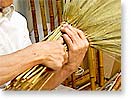 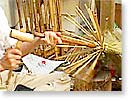 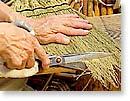
| 1.Do-jime process |
|
2.Attaching handles |
|
3.Cuts away some stems |
|
|
|
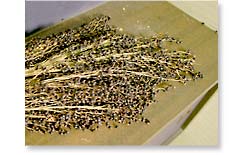 |
 |

| The Difference Between Japanese Brooms and Imports |
 |
Brooms with blue ears are made mainly outside of Japan. They get blue since they boil them in a blue dye compound after bleaching. That process weakens the fabric, so the brooms are more fragile and may be stiff. Edo brooms, which use natural grass, are strong, not very stiff, and last long. Even if one gets stiff, spraying it wet, hand combing and hanging it will make it straight. Just remember not to face them down, and spray it when its dry.
|
|
|
|
 |
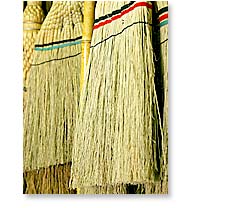 |
| How to Use an Edo Style Broom Carefully |
 |
One tip for using long handled brooms is to use it from both sides, so you can prevent it from wearing out one side. When you keep it, please face the handle side down, or hang it from the wall. If the ears of the broom for the guest room have fallen off, you can still use it for a wooden room or the kitchen. If it gets old for that, you can still use it for concrete floors or bath rooms, and then finallly for the garden. I can say that an Edo broom is an ideal recyclable item to help the environment.
|
|
|
 |